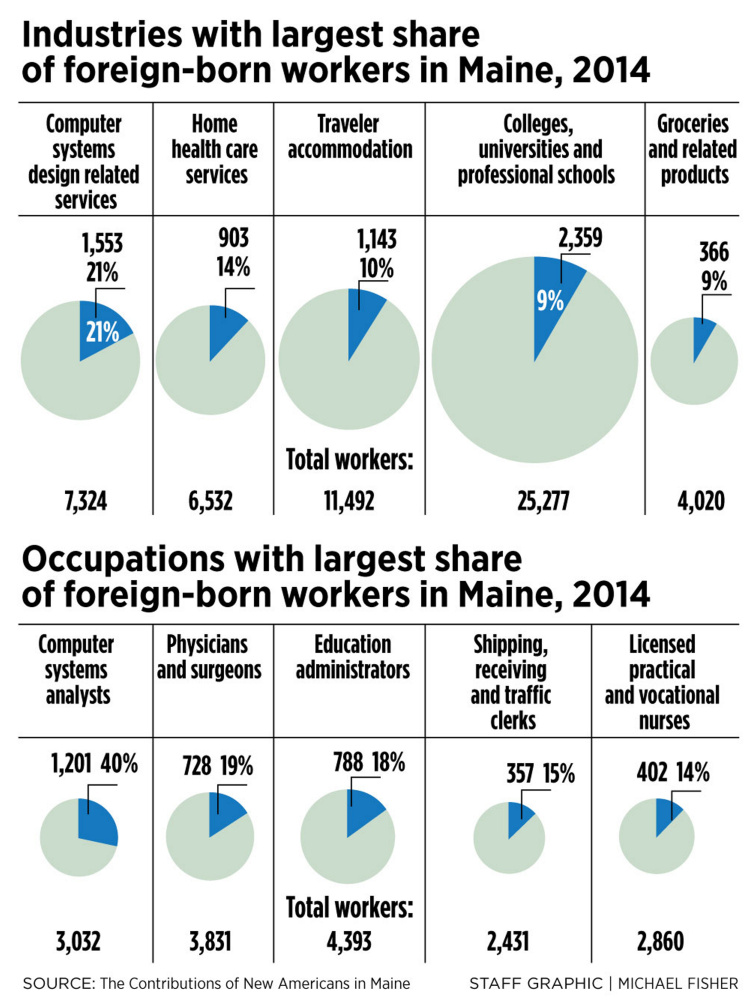Maine business leaders said Tuesday that the state needs to be more welcoming to immigrants and other newcomers to address looming workforce shortages.
It’s the latest in a string of events intended to focus attention on reforming immigration laws nationally.
Encouraging people to move to Maine is especially critical to address the problem of the state’s aging workforce, said Dana Connors, president of the Maine State Chamber of Commerce, in a media conference call with other organizations backing pro-immigration policies. More people are retiring from the workforce in Maine than are entering it, according to state data.
“If we are to continue to have the strong economy we all seek for our people we have to have the immigrant influence on our future the same way we have in the past,” Connors said. “We cannot address our workforce needs without being welcoming to immigrants.”
The Maine State Chamber of Commerce and Maine Development Foundation as well as Coastal Enterprises Inc. have released recent reports about the impact of immigrants on the state and called for policies to attract workers and families.
“The issue has been out there for many years, and now people are really feeling it and are desperate to really tap a new supply of workers,” said Carla Dickstein, senior vice president for research and policy at CEI.
The Tuesday call was organized to coincide with a new analysis of economic contributions of immigrants on Maine’s two congressional districts by the Partnership for a New American Economy, an advocacy organization launched by former New York Mayor Michael Bloomberg and media mogul Rupert Murdoch.
The analysis was based on 2014 data included in a statewide report released last year.

Cindy Caplice, human resources manager at the Sigco fabricating company in Westbrook, stands with some of her workers. Caplice says a focus on hiring African immigrants has been an unqualified success for the company.
The state’s population of about 49,000 immigrants is concentrated in southern Maine. But about 17,900 immigrants live in the second congressional district, where they make up less than 3 percent of the population and pay about $45.4 million in local and state taxes, according to the report. Almost 58 percent are of working age and there are 570 immigrant entrepreneurs in the second district.
Even though the number of immigrants seems small, they can have an outsized impact in a part of the state dealing with the decline of traditional industries and an aging workforce, said Beth Stickney, the head of the newly created Maine Business Immigration Coalition.
“I think there is a very common assumption in Maine that immigrants are a southern Maine thing, and not a northern Maine thing,” Stickney said. “In fact, immigrants are having a very important impact on the second district.”
Stickney, an immigration attorney and co-founder of Immigrant Legal Advocacy Project in Portland, wants the new coalition to be an information clearing house to help companies navigate and understand America’s complex immigration system, and a way to pass information and analysis about changes in immigration policy to business owners Some companies she has talked to just need help with basic questions, like what the difference is between a refugee, immigrant and asylum seeker, Stickney said.
“They essentially need immigration 101,” she said.
IMMIGRATION IMPACT
Data from the report show how immigrants already contribute to Maine’s economy and where they tend to find jobs. In 2014, immigrant-led households
in Maine earned $1.3 billion dollars, or 3.7 percent of all income earned by Mainers that year, and held about $954 million in spending power, defined as the net income available to a family after paying federal, state, and local taxes.
In industries such as health care and tourism, immigrant workers are essential, said the study’s authors. The top five industries that employ immigrants include computer system design, home health care services, travel accommodation, colleges and universities, and groceries.
Among the top occupations for immigrants are computer systems analysts, where 40 percent of workers are immigrants. Immigrants make up 19 percent of the state’s physicians and surgeons and 18 percent of its education administrators. Newcomers also make up about 14 percent of the state’s practical and vocational nursing workforce, 9 percent of postsecondary teachers and 8 percent of maids and house cleaners.
With the White House and Congress both controlled by Republicans, this could be an opportunity for comprehensive immigration reform that businesses have been clamoring for for years, Stickney said. Reform could affect businesses across the spectrum in Maine, from summer tourism to high-tech manufacturing, she said.
“There are a number of different areas constructed decades ago, and the laws have not been reformed to reflect the changing economic needs in the nation or our state,” she said.
Calls for more immigration contrast with a hardening political position on immigration, especially refugee resettlement and undocumented migrants, from President Trump and Gov. Paul LePage.
Trump in January ordered a ban on travel from seven majority-Muslim nations and a temporary halt to refugees that was blocked by a federal judge. On Tuesday, the Department of Homeland Security announced expanded deportation rules affect anyone in the country illegally who is charged or convicted of any crime, even minor traffic offenses.
In Maine, LePage announced in November the state would pull out of the federal refugee resettlement program, citing concerns about vetting for security threats and a burden on the state’s welfare programs.
Although some business leaders have said moves like the Trump travel ban will make it harder to bring in urgently needed workers, David Barber, of Barber Foods in Portland, said legal immigrants shouldn’t worry.
“Would I say people are a little jumpy? Sure, do I think they need to be jumpy? Not really,” Barber said.
“These people are legal, they need to be here. They don’t need to be nervous because of a change in policy.”
Peter McGuire can be contacted at 791-6325 or pmcguire@pressherald.com
Send questions/comments to the editors.



